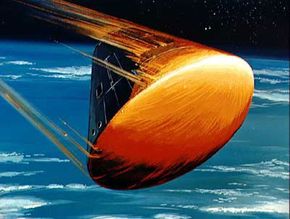Apollo's Re-entry
After jettisoning the LM, the Apollo spacecraft was ready to return home. NASA used the SM's propulsion system to insert the spacecraft into a transearth injection (TEI), which means Apollo would be heading back to Earth in a trajectory that allowed for a controlled descent into the Pacific Ocean.
To prepare for the return trip, the astronauts had to retrieve the launch couch and reinstall it for landing. Just before re-entry into the Earth's atmosphere, the astronauts jettisoned the service module from the command module. The CM then adjusted its attitude -- or orientation respective to the Earth's surface -- using its thrusters so that the base of the module faced towards the Earth's surface.
Advertisement
The temperature on the CM's surface climbed up to 5,000 degrees Fahrenheit, but the heat shields protected the inner structure of the CM. The heat shield was ablative, which means that it was designed to melt and erode away from the CM as it heated up. From the ground, it would look as if the CM had caught on fire during its descent. In reality, the ablative covering is what kept the astronauts inside the CM safe -- the material diverted heat away as it vaporized.
The atmosphere acted like a braking system on the spacecraft. To further slow the CM's descent, the spacecraft used mortar-deployed parachutes. The Apollo spacecraft had three large parachutes and could safely land with only two deployed. Eventually, the CM splashed down into the Pacific Ocean. The top of the CM housed several balloons and air compressors. If the CM landed upside down in the ocean, the astronauts could activate the balloons in an attempt to turn the spacecraft upright.
Once safe in the ocean, the spacecraft's ventilation system allowed fresh air into the capsule. The astronauts used VHF recovery beacon and radios to guide a recovery ship to the spacecraft's location. A ship recovered the crew and capsule.
The information gathered by the astronauts during the Apollo missions has become invaluable to NASA and scientific knowledge in general. In the future, NASA hopes not only to return to the moon, but also build a lunar station where people can study the moon during extensive stays.
To learn more about the space program and related topics, take a little moonwalk to the links below.
Related HowStuffWorks Articles
More Great Links
Sources
- Apollo 11 Lunar Landing Mission Press Kit. NASA. July 6, 1969.
- Apollo Program Summary Report. NASA. April, 1975.
